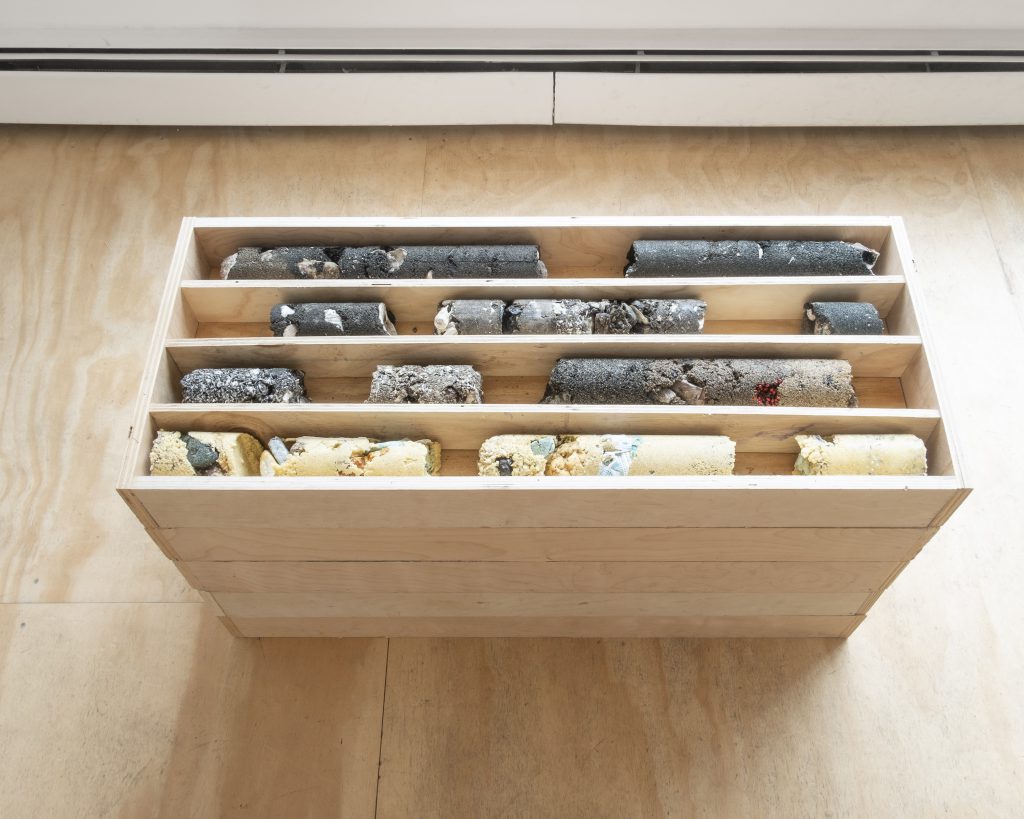The current exhibition, 4.5 Billion Years, at Brief Histories, New York defies erasure through explorations of the land.
Struggles, gains, and losses – the near past’s atrocities, as well as victories, traverse our fickle memory. Erratic in the very moment, collective furies, determinations and battles slowly settle into the dusk of remembrance; they wane like a once-scorching sun. Whether political oppression, social instability or lack of access to information, many factors cause recent histories to be veiled by the haze of forgetting, sometimes silenced out of fear or ignorance. The abundance of these “brief histories” in our modern day inspired the curator and educator couple Fawz Kabra and Isak Berbic to launch an eponymous project, “because humanity has been dealing with so many of these brief histories.” Back in 2011, they were living in Sharjah and the Arab Spring had seemed to sparkle some change in the region. The movement, the couple assumed and feared, would be one of many upheavals that eventually evanesce like a brief history. The initial group show they organised in the Emirati city included the likes of Abbas Akhavan, Larissa Sansour, Tarek Al Ghoussein, and Emilia and Ilya Kabakov.
Kabra and Berbic eventually moved their nomadic initiate to New York and opened the bricks-and-mortar Brief Histories gallery on the Lower East Side of Manhattan. On the second floor of a building on Bowery Street, synonymous with downtown grit and cool, the gallery currently hosts the group exhibition, 4.5 Billion Years at Brief Histories, New York, a title that extends the contemporary nature of human memory recklessness to the entire existence of Earth as we know it. “Our human history is just a hair on the head of the planet – so brief,” says Kabra, who organised the show. “Our presence is so tiny in comparison to the age of the rocks, the geology and the layers of Earth’s crust into its core.” The contemplation found her partially out of the gallery’s location on what was once a Native American path. “This area, the area of today’s Bowery, was one of the first major roads for the Indigenous people on the island, and when it was later occupied by Dutch Colonists, they radically appropriated the landscape into farmlands.” The couple’s musings on our physical and philosophical connection to land prompted them to invite a handful of multimedia artists into their modestly sized space.

Image courtesy of the artist and Brief Histories, New York
The show opener is CORE (2021), a work that is abundant in its terrestrial statement. Simon Benjamin’s horizontal plywood container features allusive cylinder blocks in earthy tones and rough textures. Cornmeal, sand, resin and discarded objects collected from beaches – soda cans, plastic bags and other unidentifiable finds – are compacted in these flatly placed rolls. They are on display inside the minimalist furniture-style structure like capsules of everyday time and place, everywhere and nowhere, recognisable yet foreign. The Jamaican artist’s two collages adjacent to the sculpture, titled Native Divers, Blue No. 1 and Cordillera, Blue No. 1 (both 2023), are visually subtle and dimensionally modest meditations on memory and loss. While the former includes an archival black-and-white photograph of a boat full of men, the latter holds cut-outs of found images with non-distinctive depictions – perhaps of a shore, a family home, a trip overseas. The juxtapositions of paper surfaces in deep blue acrylic complicate the lived and remembered – as the images tend to surrender to forgetting, they contest the physical reality of the nearby sculpture’s detritus-filled time capsules.
A place is rather more immediately assumed in Himali Singh Soin’s digital collage tapestry, out there/in here (2023). Printed on silk Thangka fabric, the rectangular banner includes silk cut-outs in green, blue, yellow and red, centring a pixellated image of a mountain, a female figure and a Tibetan medical chart based on an image the artist encountered at New York’s Rubin Museum. The five-peaked sacred Mount Meru is both a thought and a topological potential for Singh Soin’s fragmented embodiment of place and its imagination. In the artist’s case, depicting allusive peaks is a familial meditation as much as a creative endeavour. The daughter of a mountaineer father, Singh Soin witnessed her father’s climbing expeditions in the Himalayas in her pregnant mother’s womb. Process, pace and patience are embodied in her overall practice, which also spans performance and poetry, while in this case the banner stands as a witness to movement, drift and ascend.

Image courtesy of the artist and Brief Histories
Equally chaotic and reserved, Ali Eyal’s large-scale horizontal painting Paper, pen, map in a pocket and, (2023) leans onto the wall akin to an exhausted body. The loose – almost liquid – finishes of the brushstrokes allude to a dream or a remembrance, supported by Eyal’s layered depiction. The bottom-right corner of the canvas shows a hand holding a postcard, just like the hand holding a similar postcard within the image. The big picture, however, is torn downwards from the middle, haphazardly reunited with bits of red tape. Despite being slit, the landscape is still detectable, its oozing horizons and bountiful clouds backdropping towering human figures haunted by illusions and realities, intertwined.
Leila Seyedzadeh’s textile piece East river flows through the Alborz mountains (2023) is vertically hung by the gallery door, saluting the visitors out with its sinuous water path. The dark blue river serpents from the upper mountain through the small peaks that the artist created with found cuts of cloth in floral patterns. Soft and warm, the fabric pieces suggest another Earth, expanded between the Persian mountains and the New York river, between the past and the moment, and remembrance and forgetting.
4.5 Billion Years runs until 30 June 2023



